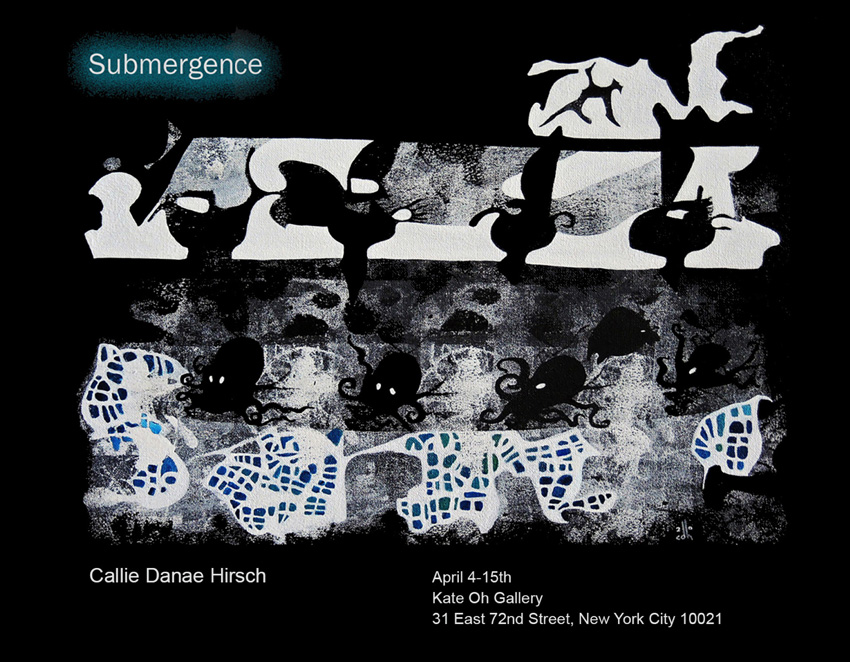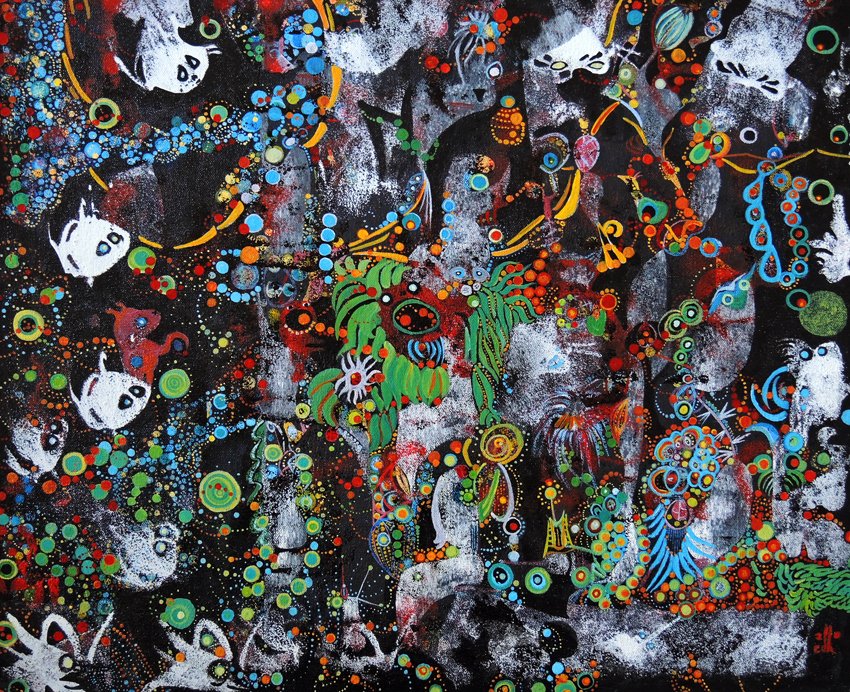|
Submergence Exhibition
by Callie Hirsch
at Kate Oh Gallery
April 4th - April 15th, 2023
31 East 72 Street, NYC
* Click here for gallery reception photos!

Submergence ii, 2023
Acrylic on canvas 19" x 25.5"
|

Submergence IV, 2023
On handmade black paper, 19" x 25.5"
|

Submergence i, acrylic on canvas 16" x 20"
Sold
|

Submergence X
Acrylic on canvas 63.5" x 52"
|

Life Cycles, 2021
Acrylic on canvas, 54" x 55"
|

Submergence XI, 2023
Acrylic on canvas 16" x 20" |

Submergence XII, 2023
Acrylic on canvas 16" x 20" Sold |

Copper Sunrise
Acrylic on canvas, 30" x 40"
|

pandemic daydream i, 2020
Acrylic on linen canvas board 16" x 20"

Submergence XVII, 2023
Acrylic on canvas, 16" x 20"

Submergencce XIX, 2023
18" x 24" Acrylic on canvas |

Submergence XX, 2023
Acrylic on linen panel, 16" x 20"
|

Body of Sea life, 2020
Acrylic on Mannequin 18” x 39” Sold
|

Moonlit Dream, 2006
Oil on canvas 51”x 64” Sold
|

Submergence VIV, 2023
Acrylic on canvas 25" x 27" Sold
|
|
Submergence
To displace one thing for another.
And so begins the exploration…momentous swirls of jetting squids, mesmerizing movements of paint on canvas, or an array of imaginary creatures; we are unsure but are tempted to follow these seemingly aimless shapes and gestures as they pivot and breathe.
“I imagine my paintings being in a constant state of flux, I never feel that the image I end up with is this static thing. It just happened to be that in this suspended moment, it all coagulated just like this when I leave the room. I like to imagine that the painting continues to undulate dissolve and that the actual process that I went through just carries on.”
– Darren Waterston
The ocean wraps around our earth connecting one being to another. Lines drawn by us to segregate are invisible, yet our generous oceans continue to hold a wealth of answers for all.
What is beneath is often unknown; cities wash away, flights disappear, ancient galleons emerge from super storms, bones drift ashore, subway cars are dropped to build barrier reefs, the great gyres swirl, drifting, sinking, reemerging. These submerged “creatures” break down, fuse together, dissipate, only to resurface thousands of miles away.
“Let us develop respect for all living things. Let us try to replace violence and intolerance with understanding and compassion. And love.”
– Jane Goodall
Show write up
by Ekin Erkan
The title of "Submergence", Callie Hirsch's new exhibition at Kate Oh Gallery, is a nod to the exhibition’s ecological theme. The pieces are semi-figurative, ocean washes and cascading briny alkaline glazes pooling over jetting squids, careening dotted fish, and the white, hoary spindles of shrimp. The paintings are semi-abstract and suggest labyrinthine picture-plans dotted with configurations similar to that of Roberto Matta’s psychological morphologies. In a sense, Hirsch’s pieces are morphologies as well. Dizzying repeated linealities and splatches of azure, mossy rock-bed and the orange threads of a wafting reef only become pellucid after the viewer has spent time with these paintings. These paintings do not reveal themselves immediately, they demand protracted viewing.
Pieces like Submergence II are arranged by an expanse of oceanic elements linking into another like a chain. A circumscribed center includes coral-peach orange parcels bordering white, creature-like dripping figures; fluxing motion is suggested by the unspooling circling of elements but there is no single figure we can pick out and easily name. Rather, this is a sea of suggestion—leafy beryl and aquamarine posits beside yellow, percolating oozes push and fade. Upon reflection, one finds Hirsch’s suggestions taking direction: wrapped seaweed, pushed by the tides into a whirlpool, the orange-white-black strippings taking the form of a clownfish.
Hirsch’s paintings engage with the emergence of the sea from a bleary-eyed cast of near-abstractions to a prismatic world in motion. Works like Submergence IV immediately remind me, at least stylistically speaking, of Gorky’s 1944 The Liver is the Cock's Comb, where suggestion again is the bridge between real-world elements and feverish abstractions. There is a kind of filling-in left to the duty of the viewer.
Art historians like Pepe Karmel have demonstrated that so-called “non-objective abstraction” always relies upon a figurative grounding for viewers to make sense of the works. That is, even the most aleatory abstraction that finds the artists drawing no inspiration at all from the empirical world still demands of the viewer some kind of sensory engagement with representational indices. For us to even take up the mantle of pre-conceptually receiving an artwork of darted splatches means we inferentially make sense of a rectangular element as not-circle-like, for instance; so begins the inferentially articulated process of likening a towering series of gestures into a totemic figure, for example. This need not be a conscious reflective process but it is nevertheless the supporting structure behind any kind of rudimentary understanding of the most abstract of abstractions. Nevertheless, such operations are performed along a spectrum of real-world contact and Hirsch’s devices are situated somewhere along the center. Alabaster whiskers usher us into more easily detecting crustaceans; a pool of inky vacuuming blankness pushes us towards the aforementioned jetting squid. Hirsch makes inventive and economical use of such figurative ciphers, a testament to her prudence as a nautical painter.
In her artist statement, Hirsch quotes Jane Goodall’s asservation that we ought to “develop respect for all living things…[replacing] violence and intolerance with understanding and compassion.” One might thus read these as activist paintings but they are subtle enough to advocate preservation without handwaving or performing more than they can make good on. Where art and protest overplay the individual’s responsibility, contra the structural (e.g., the responsibilities of corporations, governments, and legislative bodies), we are imputed with a kind of “weak resistance” the likes of recycling, veganism, and/or a minimalist lifestyle. These are all morally righteous choices but they are undoubtedly not enough to curb omnicide vis-à-vis environmental catastrophe. Hirsch’s work does not lay claim to a new mode of solving impending crises; rather, guided by the hand of suggestion, they present oceanic scenographies as a series of “publics.” These are soft, lurching environmental paintings perhaps best poised within a genealogy including figures like Ana Mendieta and Deborah Wasserman, both of whom engage the affective carnality of our environs. Hirsch does not show the ocean in toil or violently uncast; rather, she gives us dizzying motion, softly—but clearly—speaking to the seas and their inhabitants’ fleeting nature.
|
|
* click to see more art *
All site content
©Callie Danae Hirsch 2023 and use is prohibited.
All rights reserved. The designs contained on this site are copyrighted.
No part of this site may be reproduced in any form or by any means
without the
express written consent of Callie Danae Hirsch.
|
|